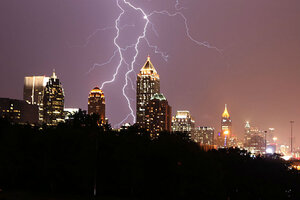How can you protect yourself from lightning?
Lightning strikes across the United States this past weekend have killed at least one person and left many others injured. How common are lightning strikes, and how can they be avoided?

Lightning lights up the midtown Atlanta sky Tuesday evening July 14, 2015, as strong storms move through the area.
Ben Gray(/Atlanta Journal-Constitution via AP
Summer is in full swing in the Northern Hemisphere, and with it a comes an increase in lightning strikes, such as the ones in the United States this weekend that left one person dead and many others injured.
On Saturday lightning hit an Alaska Airlines plane carrying 159 passengers. The Boeing 737 aircraft was designed to withstand lightning and made a safe landing with no injuries.
A hiker wasn’t so fortunate the previous day, however. On Friday, a woman died after being struck while hiking in the Rocky Mountains in Colorado. Three other hikers were injured, and one was hospitalized.
On Saturday, four teenagers were also injured by a lighting strike near a pool, also in Colorado.
According to the National Weather Service, lightning strikes in the US kill an average of around 40 people per year but hit many more: 90 percent of lightning victims survive the encounter.
These numbers are way down from the 1940s, according to John Jensenius, a meteorologist and lightning safety specialist with the National Weather Service. Back then, 300 to 400 people died from lightning strikes each year, mainly due to the prevalence of corded phones, which “when people held it right up to their head, was a direct connection with wires outside,” and a higher number of farmers sitting on uncovered tractors.
Today, nearly two-thirds of lightning deaths and injuries are sustained while engaging in outdoor leisure activities. The most dangerous are water-related pastimes, such as fishing. More than 70 percent of lightning deaths occur in June, July, and August.
For those who survive lightning strikes, there are support groups, such as Lightning Strike and Electric Shock Survivors International, which boasts around 1,800 members.
There are six different types of lightning strikes, and only around three to five percent of all victims are directly hit by the lightning. The vast majority are hit either by energy spreading through the ground from a nearby strike, or by a flash discharge from a nearby object, such as a tree, that has been struck.
"We have a very simple saying: 'When thunder roars, go indoors,’” Jensenius tells NPR. “Which means if you hear thunder, you need to be inside right away.”
Once inside, avoid using the telephone, taking a shower, washing your hands, doing dishes, or having contact with conductive surfaces, including metal doors, window frames, wiring and plumbing.
If you are stuck outside in a thunderstorm, you can slightly lower your chances of being struck by avoiding high places, open fields, isolated trees, rain or picnic shelters, communications towers, flagpoles, light poles, metal fences, convertibles, and water, the NOAA recommends.
To ascertain how far away lightning is from you, count the seconds between the flash of lightning and clap of thunder, then divide that number by 5. This will tell you how many miles away the strike is. If the time delay between seeing and hearing the lightning and thunder is less than 30 seconds, get indoors.

